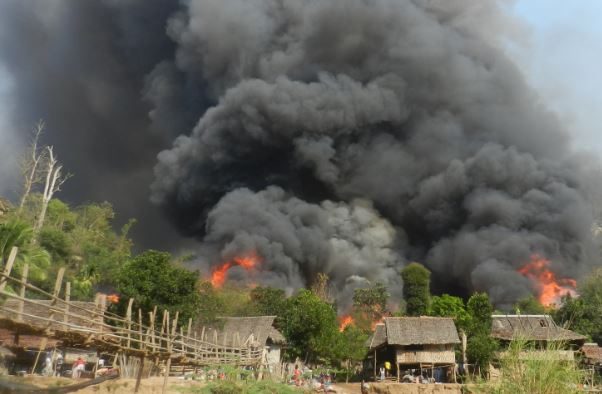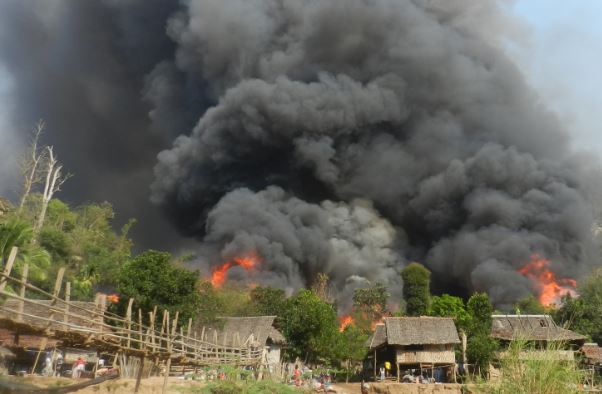One month after 38 people were killed in a fire at Mae Surin refugee camp in Thailand’s Mae Hong Son province, the circumstances that led to the fatal blaze remain unclear.
While there has yet to be an official declaration of the cause of the fire, media reports have pointed to three possible explanations: a cooking accident, a forest fire and arson.
The blaze injured at least 100, destroyed over 400 houses, displaced about 2,300. Sally Thompson, the director of the The Border Consortium, a humanitarian agency who have been providing aid and supplies to nine Burmese refugee camps since 1984, said that the tragedy at Mae Surin camp recorded the highest death toll in 25 years.
Thompson said that there had been 12 incidents of fire in different refugee camps since 1984. However, there had never been a death toll like this in the past even though the refugees in nine camps had experienced tragedies including natural disasters.
“It [the death toll] is the highest that we have got. We have had natural disasters. We have had floods, we have had fires, we have had cross-border attacks, mortar shelling in the camps. But that has never been such a heavy loss of life” said Thompson.
Hardly accessible by trucks, Mae Surin camp is located in very remote territory, about one and half hours drive from Khun Yuam district in Mae Hong Son province. The camp houses about 3,000 people mostly Christian Karenni and Karen. They fled from their homes in eastern Burma due to military attacks lunched by the Burmese army.
A few days after the fire, I travelled to the refugee camp to hear witness accounts and testimony from the refugees in order to find out the cause of the fire.
I learnt that Thai border security forces started to restrict the flow of visitors who intended to distribute aid into the devastated refugee camp on March 31. Only vehicles belonging to Thai authorities such as army and police are allowed access to the camp.
Individuals who went to deliver aid to the camp was asked by the Thai army to drop their aid at a store in Khun Yuam district in Mae Hong Son. Aid delivery would only be carred out by the local government offices.
The local authorities said that no outsiders are allowed to visit the camp as there are so many vehicles in the camp, creating traffic jams. They also said the road to the camp was in poor condition.
At a military checkpoint near Ban Mae Sapin, on the route from Khun Yuam to Mae Surin camp, the vehicle I travelled in was stopped by a Thai military commander who asked us to return to Khun Yuam District office and seek permission.
The Thai commander said, “If I allow you guys, I will need to be responsible. I am not authorized to give you permission. So, please go back and ask for entry permission.” He then gave us a letter written in Thai and asked us to go back to seek official permission.
When we went back to Khun Yuam District office, local authorities also asked us to drop our aid there. However, we finally managed to follow the aid convoy of a Thai Television station, Channel 3, into the camp.
When we reached the camp, found there were not many vehicles, except vehicles belong to the Thai army, police and few local Thai. The road was isolated, but not in bad condition.
Talking with about two dozens of refugees including camp authorities, local fire fighters, victims, and witnesses who saw planes before the start of the fire in the camp, none of them said the cause of the fire was a cooking accident or seasonal forest fire.
Shally Than, the chairwoman of the camp said that there was no forest fire on the day the fire broke out. It was not cooking time either when the fire started, she said. The fire started around 3 p.m. Refugees in the camp normally start to cook for dinner from 4 to 5 p.m.
The owner of the house when the fire started also told the camp’s local information team that she was not at her house when the fire started.
Sai Htun, the head of the information team said the house owner told him that she was not cooking as she was not at her home. Several neighbours repeated that the home owner was not at her home, but left sleeping child there.
One of her neighbours, Kler Yeh Htoo, a local fire fighter said that the fire started in the bed room, not in the kitchen.
Kler Yeh Htoo whose house was also burnt said that he noticed smoke at the roof of his house before the fire started. The smoke looked like vapour before it become flame, he added.
Several witnesses in the camp said they saw three white planes before the fire started. One 14-year-old boy said that he saw the planes while he was climbing on a hill near the camp to search for seasonal vegetable. He said the first one flew lower and the other two flew higher.
“They weren’t helicopters, but small, white planes,” he said.
“The first one seemed to release something, like a white power or smoke, while the other two were just flying around nearby. After a while, the first plane almost disappeared from sight and the other two followed it.”
The boy said that shortly after the planes flew away, he saw plumes of smoke billowing from the camp.
Supporting the idea that something was dropped on to the camp from the air, several witnesses said they saw small crystals falling on to the roofs of their homes. Some described the particles as looking like salt, while others said it resembled fertilizer.
A number of people who helped tackled the blaze said it seemed to grow in strength when they threw water on to it. They said they were also perplexed at how several houses escaped unscathed while neighbouring properties were razed to the ground.
Thai policeare now carrying out an investigation of the damaged site at the camp. They had circled the area where the first fire started with yellow tape marked: DO NOT ENTER. Refugees said that the police questioned people, but didn’t say when they will announce their findings.
While the investigation is underway, the clearance process is proceeding rapidly. Three bulldozers are now working everyday in the site, preparing the damaged sites for the reconstruction.
Some of the spots where the fire first broke out such as the camp’s hospital and bible school were already cleaned up.
Pol Col Nitinart Wittayawuthikul, the Khun Yuam district police chief, said that he has learned that some damaged sites were already destroyed and cleaned up and it was not possible to investigate them properly.
Pol Col Wittayawuthikul was transferred from Khun Yuam to Mae Hong Son after he refused to say that the cause of fire was an “accident.” Despite reports saying that he was transferred due to a failure to carry out his duties properly, Wittayawuthikul said that he has arrived at the camp after the blaze and talked to more than 20 refugees.
He said he doesn’t believe the cause of the fire was an cooking accident. He also said there was no forest fire near the camp and no strong wind when he reached at the camp.
Something else that made the police officer suspicious was the colour of the smoke created by the fire.
“The smoke was dark, like when you burn chemicals or rubber tyres. Smoke from house fires, because the properties are made from natural materials such as bamboo and leaves, is usually white,” he said.
An unnamed source from the police forensic team said traces of phosphorus had been found in the area close to where the blaze is believed to have started.
“Some people have told me to shut my mouth. But I can’t. Those refugees have spilt blood and lost lives. So I have to tell the truth,” Pol Col Wittayawuthikul added.
The security presence has led to the refugees fearing for their safety now.
The head of the camp’s legal team, Sai Htun, said that refugees were afraid to talk about what happened.
Now people don’t dare to talk about the incident any more. They afraid to give their witness account. They are afraid of security forces.
“As we are refugees, there is no guarantee for our safety due to our status as stateless people,” said Sai Htun.
Saw Yan Naing is a reporter for Irrawaddy Magazine who has also written for the Bangkok Post, Asia Times Online and Al Jazeera.
 Facebook
Facebook  Twitter
Twitter  Soundcloud
Soundcloud  Youtube
Youtube  Rss
Rss 
